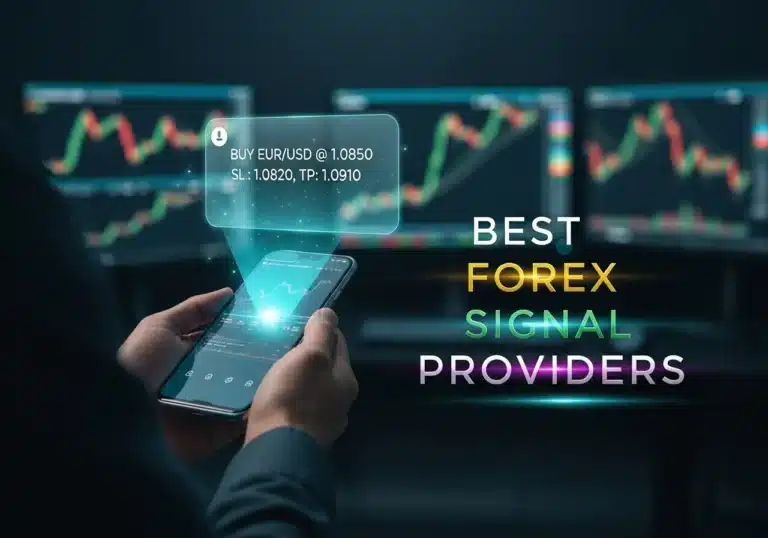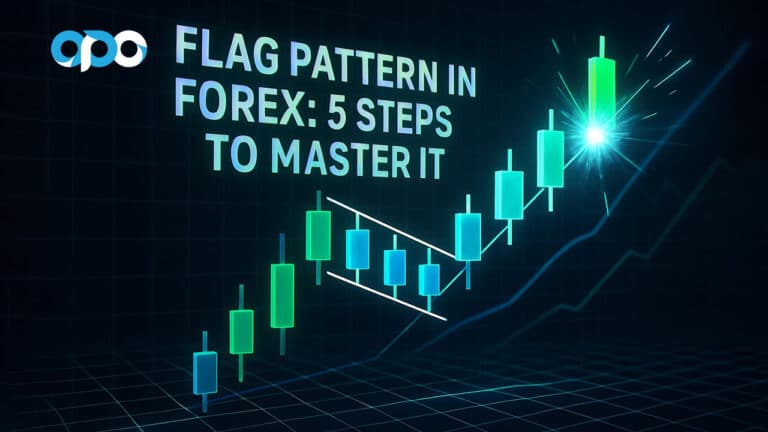In today’s dynamic financial markets, traders are constantly seeking effective strategies to maximize returns while managing risks. The debate of Copy Trading Vs. Manual Trading involves two distinct approaches that cater to different types of traders with varying skill levels, time commitments, and objectives. For those navigating the complex world of forex trading, understanding the fundamental differences when considering Copy Trading Vs. Manual Trading is crucial before partnering with a forex broker.
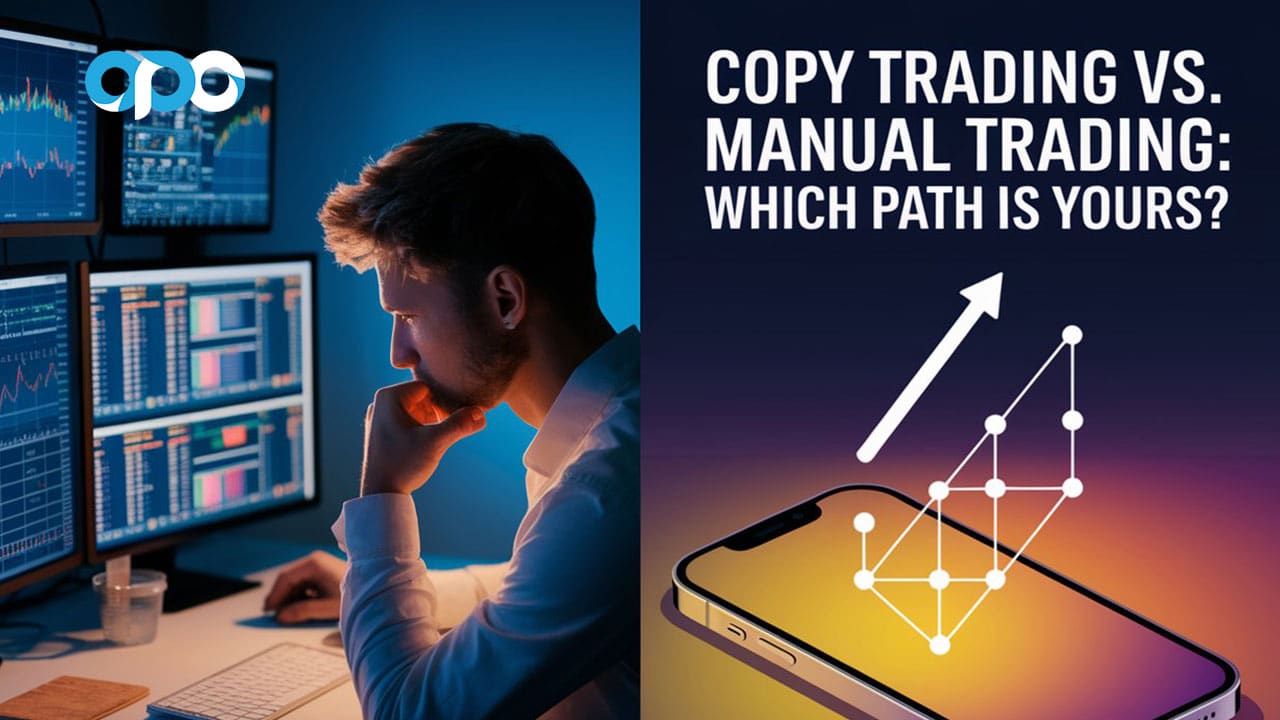
Copy trading allows investors to automatically replicate the trades of experienced traders, while manual trading involves independent analysis and decision-making. This comprehensive Copy Trading Vs. Manual Trading comparison examines both approaches in detail, helping you determine which strategy aligns better with your trading goals, experience level, and lifestyle preferences.
Understanding Copy Trading
Before diving into the specifics, let’s establish a clear understanding of what copy trading entails. This section breaks down the core concepts, key players, and the mechanics behind this automated trading approach, setting the stage for comparing it against manual methods in the Copy Trading Vs. Manual Trading discussion.

What Is Copy Trading?
Copy trading represents a modern approach to financial markets that allows investors to automatically replicate the trades of experienced traders. This innovative system creates a bridge between novice investors seeking market exposure and seasoned traders with proven track records. At its core, copy trading is a strategy where traders mirror the techniques and positions of others in real-time, creating an ecosystem of signal providers and copiers within the trading community.
Definition and Concept
Copy trading is fundamentally different from traditional trading methods as it enables investors to automatically duplicate the trading activities of selected experts. Unlike social trading, which involves exchanging ideas and learning from others, copy trading takes this concept further by automating the execution process. When a signal provider opens a position, the same trade is instantly executed in the copier’s account, maintaining the proportional size based on allocated funds.
Key Players: Signal Providers and Copiers
The copy trading ecosystem consists of two primary participants:
- Signal Providers: These are experienced traders who allow others to copy their trading strategies. They often receive compensation through subscription fees or commissions based on their performance and number of followers.
- Copiers: These are typically less experienced investors who choose to follow signal providers based on their historical performance, risk profiles, and trading strategies. Copiers allocate a portion of their capital to automatically mirror the trades of their chosen experts.
Read More: Price Action in Forex Trading
How Does Copy Trading Work?
Copy trading platforms connect signal providers with potential copiers through sophisticated technological infrastructure. These platforms typically display comprehensive performance metrics, risk assessments, and historical data of available signal providers, helping copiers make informed decisions about whom to follow.
Automated Execution vs Manual Decision-making
The primary distinction between copy trading and manual approaches lies in the execution process. In copy trading:
- Trades are executed automatically without requiring the copier’s intervention
- Position sizing is typically proportional to the allocated capital
- Entry and exit points are determined by the signal provider’s actions
- Risk management parameters can often be preset by copiers
This automated nature stands in stark contrast to manual trading, where traders must actively monitor markets and execute trades based on their own analysis and decision-making process.
Role of Technology in Replicating Trades
Advanced algorithms and connectivity solutions enable the seamless replication of trades across multiple accounts. When a signal provider executes a trade, the copy trading platform instantly mirrors this action across all connected follower accounts, adjusting position sizes proportionally based on each copier’s allocated funds.
Modern copy trading platforms incorporate features like:
- Real-time synchronization between provider and copier accounts
- Automated risk management tools
- Performance analytics and reporting
- Social elements for community engagement and learning
Benefits of Copy Trading
Copy trading offers several advantages that make it particularly attractive to certain types of traders.
Accessibility for Beginners
Copy trading significantly lowers the entry barriers to financial markets. Beginners can participate in sophisticated trading strategies without possessing extensive market knowledge. This accessibility democratizes trading by allowing newcomers to benefit from the expertise of professional traders while gradually learning market dynamics.
Time-Saving Automation
For individuals with limited time to devote to market analysis, copy trading provides an efficient alternative. The automated nature of this approach eliminates the need for constant market monitoring, technical analysis, and trade execution. This time efficiency makes copy trading particularly suitable for:
- Busy professionals with full-time commitments
- Passive investors seeking market exposure
- Those learning trading fundamentals who aren’t ready for independent execution
Diversification Opportunities
Copy trading enables traders to diversify their approach by following multiple signal providers with varying strategies. This diversification can potentially reduce risk and enhance returns by spreading investments across different trading styles, asset classes, and timeframes.
Risks of Copy Trading
Despite its advantages, copy trading comes with significant risks that potential users should carefully consider.
Dependency on Signal Providers
Perhaps the most significant drawback of copy trading is the dependency it creates on external parties. Copiers must trust the judgment, skill, and discipline of their chosen signal providers. If a provider makes poor decisions or experiences a losing streak, these negative outcomes are automatically replicated in copiers’ accounts.
Platform Fees and Transparency Issues
Copy trading services typically involve various fees, including:
- Subscription costs for following premium signal providers
- Platform usage fees
- Performance-based commissions
- Potential spread markups
Additionally, transparency issues may arise regarding signal providers’ true performance histories, risk management practices, or conflicts of interest.
Market Volatility and Losses
Copy trading does not eliminate market risk. During periods of extreme volatility, automated systems may face execution delays or pricing issues that can amplify losses. Furthermore, past performance of signal providers offers no guarantee of future results, and blindly following strategies without understanding their underlying principles can lead to significant financial losses.
Read More: Price Action vs ICT
Exploring Manual Trading
Moving to the other side of the spectrum in the Copy Trading Vs. Manual Trading comparison, manual trading represents the traditional way of engaging with markets. Here, we’ll examine the principles of independent decision-making, the importance of research, and the hands-on nature of this method.
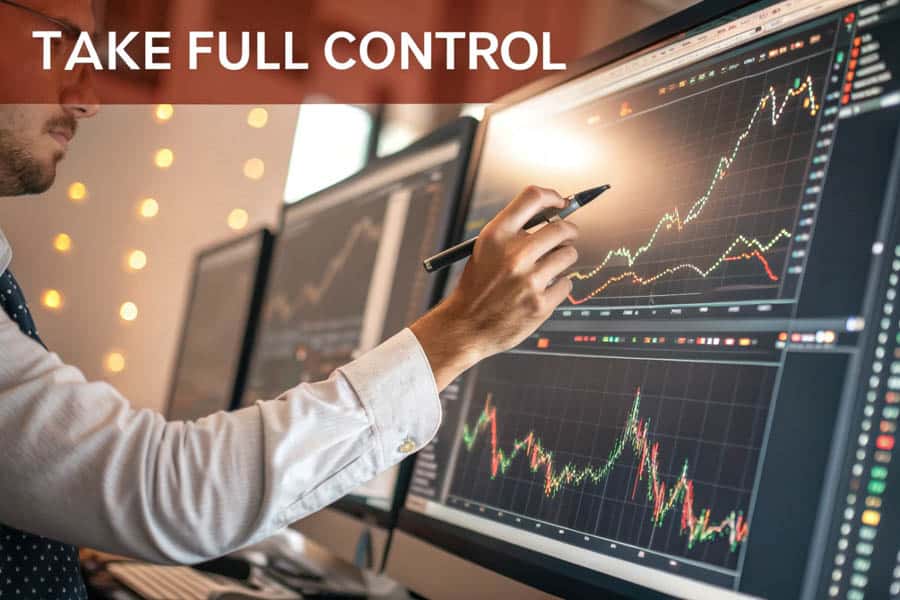
What Is Manual Trading?
Manual trading represents the traditional approach to financial markets, where traders independently analyze market conditions, develop strategies, and execute trades based on their own judgment and expertise. This method gives traders complete control over their trading activities, from research and analysis to execution and risk management.
Independent Decision-making Process
At its core, manual trading revolves around independent decision-making based on:
- Technical analysis using charts, indicators, and patterns
- Fundamental analysis of economic data and news events
- Market sentiment assessment
- Risk-reward calculations
- Trade sizing and position management
This hands-on approach requires traders to develop their own methodology, establish entry and exit criteria, and make real-time decisions based on market developments.
Role of Market Analysis and Research
Manual trading demands substantial market analysis and ongoing research. Traders must:
- Continuously monitor price movements and market conditions
- Analyze technical indicators and chart patterns
- Stay informed about economic events and news developments
- Evaluate the potential impact of global events on market dynamics
- Refine strategies based on performance analysis
This analytical component distinguishes manual trading from automated approaches, requiring traders to develop and apply their own expertise rather than relying on others’ judgments.
Advantages of Manual Trading
Manual trading offers several distinct advantages that make it the preferred method for many experienced market participants.
Full Control Over Trades
The most significant benefit of manual trading is the complete control it provides. Traders can:
- Make independent decisions based on their unique market perspective
- Adjust strategies in real-time as market conditions change
- Exercise discretion when unusual situations arise
- Implement personalized risk management protocols
- Adapt to emerging market opportunities quickly
This autonomy allows traders to fully leverage their knowledge and intuition, potentially leading to superior results compared to automated systems in certain market conditions.
Flexibility in Strategy Adjustment
Manual trading offers unparalleled flexibility to adapt strategies based on changing market dynamics. Traders can:
- Modify their approach when market conditions shift
- Incorporate new information immediately into decision-making
- Adjust position sizes based on conviction levels
- Switch between different methodologies as needed
- Implement creative solutions to unique market scenarios
This adaptability is particularly valuable during unusual market events or rapid changes in volatility regimes.
Potential for Higher Returns with Skill
Skilled manual traders have the potential to achieve superior returns by:
- Identifying opportunities that automated systems might miss
- Applying nuanced judgment to complex market situations
- Exercising patience and discipline in trade execution
- Capitalizing on market inefficiencies or sentiment extremes
- Combining multiple analysis techniques for comprehensive decision-making
The human element in manual trading—intuition, pattern recognition, and contextual awareness—can provide a significant edge in certain market environments.
Drawbacks of Manual Trading
Despite its advantages, manual trading presents several challenges and potential drawbacks.
Time Commitment and Emotional Biases
Manual trading requires substantial time investment for:
- Market monitoring and analysis
- Strategy development and testing
- Trade execution and management
- Performance review and improvement
Additionally, emotions can significantly impact decision-making, leading to common trading errors like:
- Holding losing positions too long
- Taking profits too early
- Overtrading during volatile periods
- Hesitating to enter valid trading setups
- Making impulsive decisions during market stress
These emotional biases can undermine even the most sophisticated trading strategies and represent a significant challenge for manual traders.
Risk of Errors Without Discipline
Without strict discipline, manual trading can lead to:
- Inconsistent application of trading rules
- Deviation from established risk management principles
- Poor position sizing decisions
- Impulsive entries based on FOMO (fear of missing out)
- Revenge trading after losses
These behavioral pitfalls can significantly impact performance and are often cited as the primary reason many traders fail to achieve consistent results.
Requirement for Market Expertise
Perhaps the most significant barrier to successful manual trading is the extensive knowledge and expertise required. Traders must develop:
- Technical analysis proficiency
- Understanding of market structures and dynamics
- Risk management expertise
- Psychological discipline
- Trade execution skills
Acquiring these competencies requires substantial investment in education, practice, and experience, creating a steep learning curve for newcomers to financial markets.
Read More: Price action vs Elliott wave
Comparing Copy Trading and Manual Trading
Now that we’ve defined both approaches, it’s crucial to directly compare them across key dimensions. This section highlights the fundamental differences in control, time investment, risk management, and required expertise inherent in the Copy Trading Vs. Manual Trading debate, helping clarify which might be better suited for different individuals.
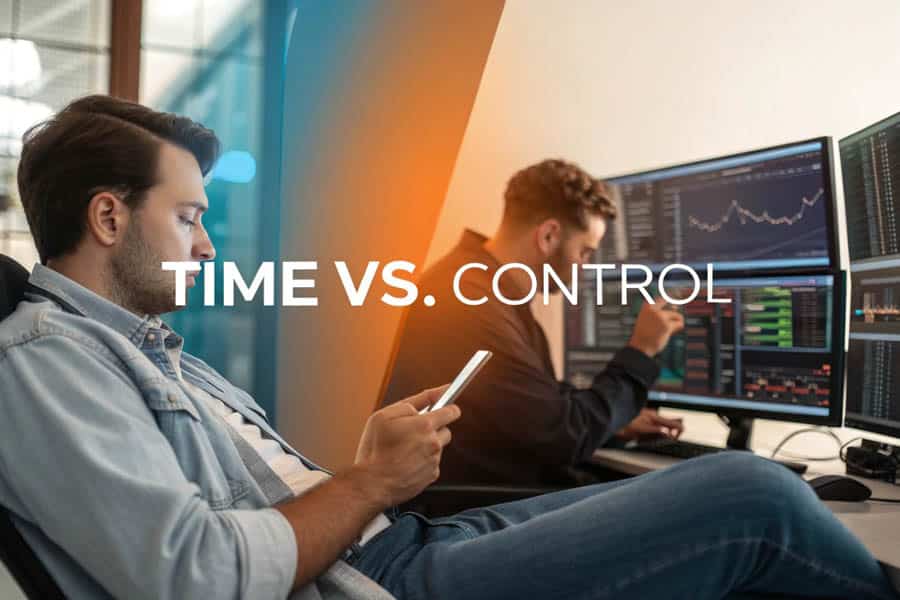
Control and Involvement
The level of control and involvement represents a fundamental difference in the Copy Trading Vs. Manual Trading equation.
Copy trading offers a more passive experience where:
- Trading decisions are delegated to signal providers
- Position management is largely automated
- Strategy development is outsourced
- Analysis is performed by others
In contrast, manual trading provides:
- Complete decision-making autonomy
- Direct control over every aspect of trading
- Personalized strategy implementation
- Hands-on market engagement
This distinction in control is central to the Copy Trading Vs. Manual Trading decision, as it directly impacts the trader’s relationship with the market and their investment process.
Time Commitment
When considering Copy Trading Vs. Manual Trading, the time required varies significantly:
Copy trading typically requires:
- Initial research to select appropriate signal providers
- Periodic monitoring of performance
- Occasional reallocation of funds between providers
- Limited ongoing market analysis
Manual trading demands:
- Continuous market monitoring
- Regular technical and fundamental analysis
- Active trade management
- Ongoing strategy refinement and education
This time commitment difference makes each approach suitable for different lifestyle situations and personal preferences.
Risk Management and Flexibility
Risk management is another key differentiator in the Copy Trading Vs. Manual Trading analysis:
In copy trading:
- Risk parameters can often be preset (stop-loss percentages, maximum drawdown limits)
- Diversification across multiple providers is possible
- Overall exposure is limited by allocation decisions
- Risk management execution ultimately depends on signal providers
Manual trading allows for:
- Customized risk management for each trade
- Real-time adjustment based on changing market conditions
- Personalized position sizing methodologies
- Implementation of complex hedging strategies when needed
This difference in risk management flexibility in the Copy Trading Vs. Manual Trading context can significantly impact trading outcomes, particularly during volatile market periods.
Skill Level Required
The skill level required is a major factor in the Copy Trading Vs. Manual Trading choice:
Copy trading is accessible to:
- Complete beginners with limited market knowledge
- Passive investors seeking market exposure
- Those lacking technical analysis skills
- Individuals without time for extensive market research
Manual trading is better suited for:
- Experienced traders with developed analytical skills
- Those with strong discipline and emotional control
- Individuals with substantial market knowledge
- Traders who have developed personalized strategies
This skill distinction, a key aspect of Copy Trading Vs. Manual Trading, makes each appropriate for different stages of a trader’s development journey.
Choosing the Right Strategy for You
Selecting the optimal approach isn’t a one-size-fits-all decision when evaluating Copy Trading Vs. Manual Trading. This part guides you through the personal factors to consider, helping you determine whether copy trading or manual trading aligns better with your specific circumstances and objectives.
Factors to Consider
Selecting between copy trading and manual trading requires careful consideration of several personal factors:
Time Availability for Monitoring Trades
Your available time for market engagement should significantly influence your choice:
- If you have limited time due to work, family, or other commitments, copy trading offers a more time-efficient solution that doesn’t require constant market monitoring.
- If you can dedicate several hours daily to market analysis and trade management, manual trading allows you to leverage this time investment for potentially superior results.
Risk Tolerance Levels
Your comfort with different types of risk impacts which approach might be more suitable:
- Copy trading introduces dependency risk (relying on others’ decisions) but can reduce analytical errors for beginners.
- Manual trading eliminates dependency risk but increases the possibility of personal analytical and emotional errors.
Each approach distributes risk differently rather than eliminating it entirely.
Knowledge of Market Dynamics
Your current understanding of financial markets should influence your decision:
- Beginners with limited market knowledge might benefit from copy trading as an educational starting point while gradually developing their own expertise.
- Intermediate and advanced traders with established market understanding can leverage their knowledge more effectively through manual trading.
The optimal approach may evolve as your knowledge and experience grow over time.
Who Should Choose Copy Trading?
Copy trading is particularly well-suited for:
Ideal for Beginners or Busy Individuals
Copy trading presents a compelling option for:
- Market newcomers seeking exposure while learning
- Busy professionals without time for detailed analysis
- Passive investors looking for potentially higher returns than traditional investments
- Those struggling with the emotional aspects of trading
- Individuals interested in markets but lacking technical expertise

For these groups, copy trading offers market participation with reduced time commitment and technical knowledge requirements while providing valuable learning opportunities through observation of successful traders’ strategies.
Who Should Opt for Manual Trading?
Manual trading is better aligned with the needs and capabilities of:
Suited for Experienced Traders Seeking Control
Manual trading represents the preferred approach for:
- Experienced traders with developed analytical skills
- Those who value complete decision-making autonomy
- Active traders seeking to implement personalized strategies
- Individuals who have conquered emotional trading challenges
- Those who enjoy the analytical and strategic aspects of trading

For these traders, the control, flexibility, and potential for superior returns through skilled analysis outweigh the additional time commitment and responsibility that manual trading requires.
Opofinance Services
Regardless of whether you lean towards copy trading or manual trading in the ongoing Copy Trading Vs. Manual Trading assessment, partnering with the right broker is paramount. This section briefly introduces Opofinance and how its services cater to the needs of traders using either methodology.
For traders considering either copy trading or manual trading approaches, selecting a reliable, regulated forex broker is essential. ASIC-regulated Opofinance offers comprehensive solutions catering to both trading styles:
- Advanced Trading Platforms – Trade on MT4, MT5, cTrader, and OpoTrade with a single account, providing flexibility for both copy and manual traders.
- Innovative AI Tools – Utilize AI Market Analyzer, AI Coach, and AI Support to enhance your trading decisions regardless of your preferred approach.
- Social & Prop Trading – Benefit from Opofinance’s social trading features that allow you to copy top traders while growing your skills, or participate in their revolutionary prop trading program.
- Secure & Flexible Transactions – Safe and convenient deposits and withdrawals methods including crypto payments, with zero fees from Opofinance.
- Transparent Trading Environment – Experience real transparent trading with full visibility of market conditions, especially beneficial with their cTrader ECN Account that provides direct market access.

Ready to start your trading journey with the right tools and support? Visit Opofinance today to explore their comprehensive trading solutions.
Conclusion
Summarizing the key points discussed, this concluding section reinforces the main distinctions between copy trading and manual trading and emphasizes the importance of aligning your choice with your personal trading profile. The Copy Trading Vs. Manual Trading decision is personal, but understanding the core differences is key.
The ultimate Copy Trading Vs. Manual Trading choice depends on your individual circumstances, goals, and trading personality. In the Copy Trading Vs. Manual Trading landscape, both offer distinct advantages and challenges that make them suitable for different types of traders.
Copy trading provides accessibility, time efficiency, and reduced emotional decision-making, making it particularly valuable for beginners, busy professionals, or those seeking diversification through multiple trading styles. However, it creates dependency on signal providers and may limit learning opportunities if used without educational intent.
Manual trading offers complete control, maximum flexibility, and potentially higher returns for skilled practitioners. This approach requires significant time investment, substantial market knowledge, and strong emotional discipline, making it better suited for experienced traders or those committed to developing comprehensive trading expertise.
Many successful traders adopt a hybrid approach, utilizing copy trading for certain asset classes or during busy periods while engaging in manual trading when time and market conditions allow. This combined strategy leverages the strengths of both methods while mitigating their individual weaknesses.
Regardless of which approach you choose, continuous learning, disciplined risk management, and realistic expectations remain essential for long-term trading success. The financial markets reward knowledge, patience, and strategic thinking—qualities that can be developed through either copy trading or manual trading when approached with the right mindset.
Key Takeaways
To distill the core information from our Copy Trading Vs. Manual Trading analysis, here are the essential points comparing the two approaches, providing a quick reference guide.
- Understanding the core differences in Copy Trading Vs. Manual Trading is the first step.
- Copy trading automates the trading process by replicating experienced traders’ positions, while manual trading requires independent analysis and execution.
- Time commitment represents a major difference—copy trading requires minimal ongoing management, while manual trading demands continuous market monitoring.
- Risk management differs significantly, with copy trading delegating many decisions to signal providers while manual trading offers complete control.
- Beginner traders and busy professionals often benefit from copy trading’s accessibility, while experienced traders typically prefer manual trading’s flexibility.
- Many successful traders employ both approaches strategically, leveraging the strengths of each method in different market conditions.
- Selecting a regulated forex broker with robust platforms like Opofinance is crucial regardless of your chosen trading approach.
Pro Tips for Advanced Traders:
For those already experienced in the markets and looking beyond the basic Copy Trading Vs. Manual Trading dilemma, optimizing your strategy is key. These tips offer advanced techniques applicable whether you primarily use copy trading, manual trading, or a hybrid approach.
- Strategic Hybridization – Allocate capital strategically between copy and manual trading based on market conditions and time availability. During periods of high certainty or specific market expertise, increase manual trading allocation, while shifting toward copy trading during uncertain phases or time constraints.
- Analytical Copy Trading – Don’t approach copy trading as entirely passive. Analyze the performance patterns of signal providers, understanding which market conditions favor their strategies. This informed approach to copy trading can significantly enhance results compared to blind following.
- Psychological Journaling – For manual traders, maintain a detailed trading journal focused not just on entries and exits but on psychological states during decisions. Identifying emotional patterns that lead to poor choices allows for targeted improvement in trading psychology.
- Custom Risk Algorithms – Develop personalized risk management algorithms that dynamically adjust position sizing based on recent performance, market volatility, and correlation between open positions. This advanced approach to risk management can dramatically improve risk-adjusted returns.
- Performance Attribution Analysis – Regularly conduct detailed attribution analysis to identify which aspects of your trading (entry timing, exit management, position sizing, market selection) are contributing to or detracting from performance. This granular understanding enables targeted improvement efforts.
How do taxes differ between copy trading and manual trading?
Tax implications can vary significantly between copy trading and manual trading depending on your jurisdiction. Copy trading may be classified as passive income in some regions, potentially subject to different tax rates than active trading income. Additionally, some countries may treat copy trading as a form of investment management service, with unique tax considerations. Manual trading typically falls under standard trading tax regulations, with profits taxed as capital gains or business income depending on trading frequency and intent. Consult with a tax professional familiar with trading activities in your jurisdiction to ensure proper compliance with local regulations.
Can copy trading be used as an educational tool for developing manual trading skills?
Yes, copy trading can serve as an excellent educational bridge toward manual trading mastery. By following experienced traders, newcomers can observe professional decision-making in real-time, studying entry and exit patterns, position sizing methodologies, and market condition responses. Many traders use a “shadow learning” approach—following signal providers while simultaneously analyzing why these trades might have been taken based on technical or fundamental factors. This parallel learning process accelerates understanding of market dynamics and trading psychology while providing real market exposure with potentially reduced risk compared to purely self-directed learning.
How does market volatility affect the performance gap between copy trading and manual trading?
Market volatility creates interesting performance divergences between copy trading and manual trading approaches. During extreme volatility, manual traders with strong emotional discipline can outperform by capitalizing on overreactions while avoiding panic decisions. However, most manual traders struggle with emotional control during high volatility, potentially making copy trading’s emotional detachment advantageous. Conversely, many copy trading systems have risk management parameters that automatically reduce position sizes during volatility spikes, potentially missing opportunities that disciplined manual traders might capture. The performance gap ultimately depends on the specific signal providers’ volatility adaptation strategies compared to the individual manual trader’s psychological resilience during market stress.





